Intercontinental Hotels Group Strategic Management Plan Report
VerifiedAdded on 2023/06/10
|14
|4625
|302
AI Summary
This report provides a comprehensive analysis of the strategic management plan for Intercontinental Hotels Group, including an analysis of the impact of macro-environment, SWOT and PESTEL analysis, competitive analysis, and McKinsey's 7s Framework. It also includes a strategic planning section with Porter's Generic Strategies and Ansoff Growth Matrix. The report covers the internal and external environmental analysis with competitive analysis of the hotel by using various business frameworks.
Contribute Materials
Your contribution can guide someone’s learning journey. Share your
documents today.
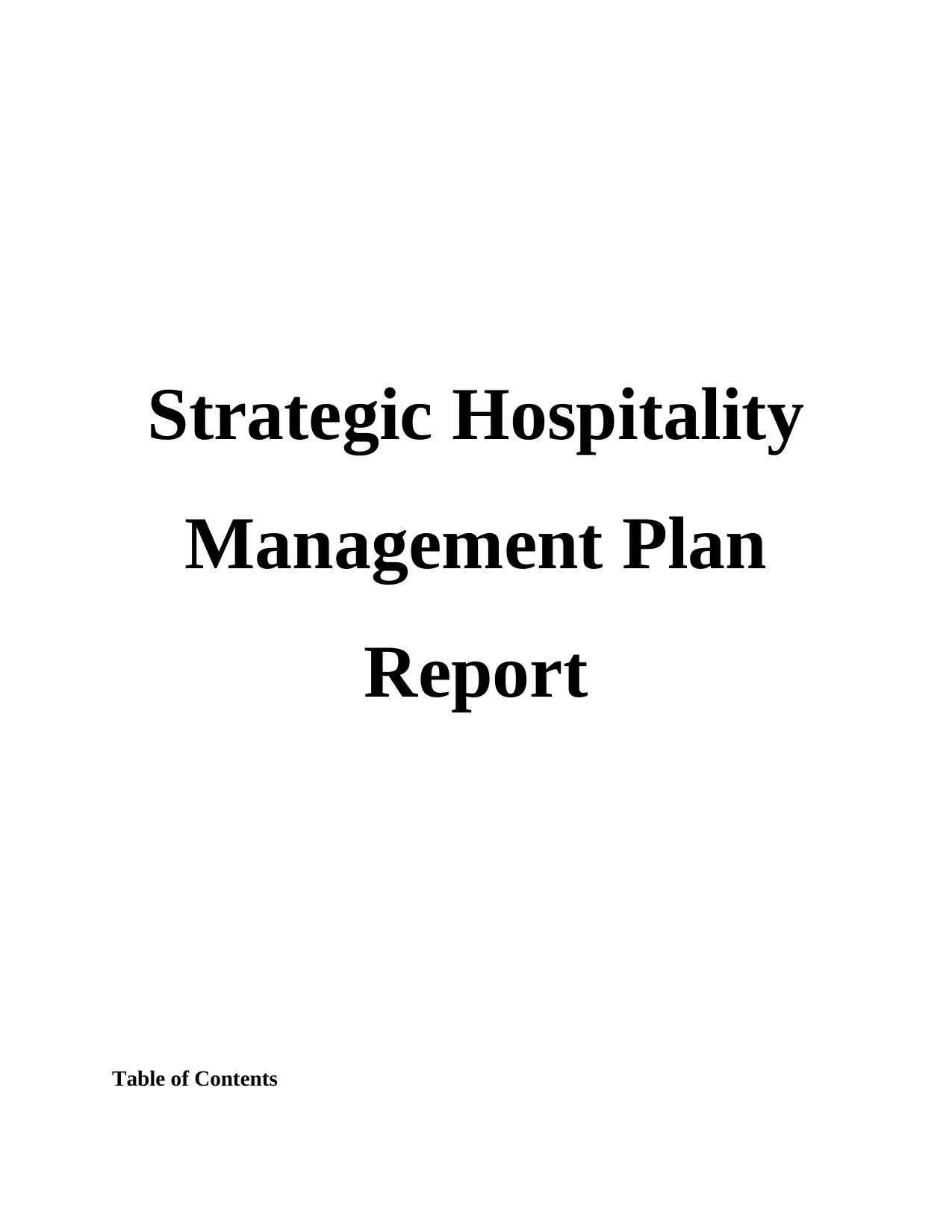
Strategic Hospitality
Management Plan
Report
Table of Contents
Management Plan
Report
Table of Contents
Secure Best Marks with AI Grader
Need help grading? Try our AI Grader for instant feedback on your assignments.
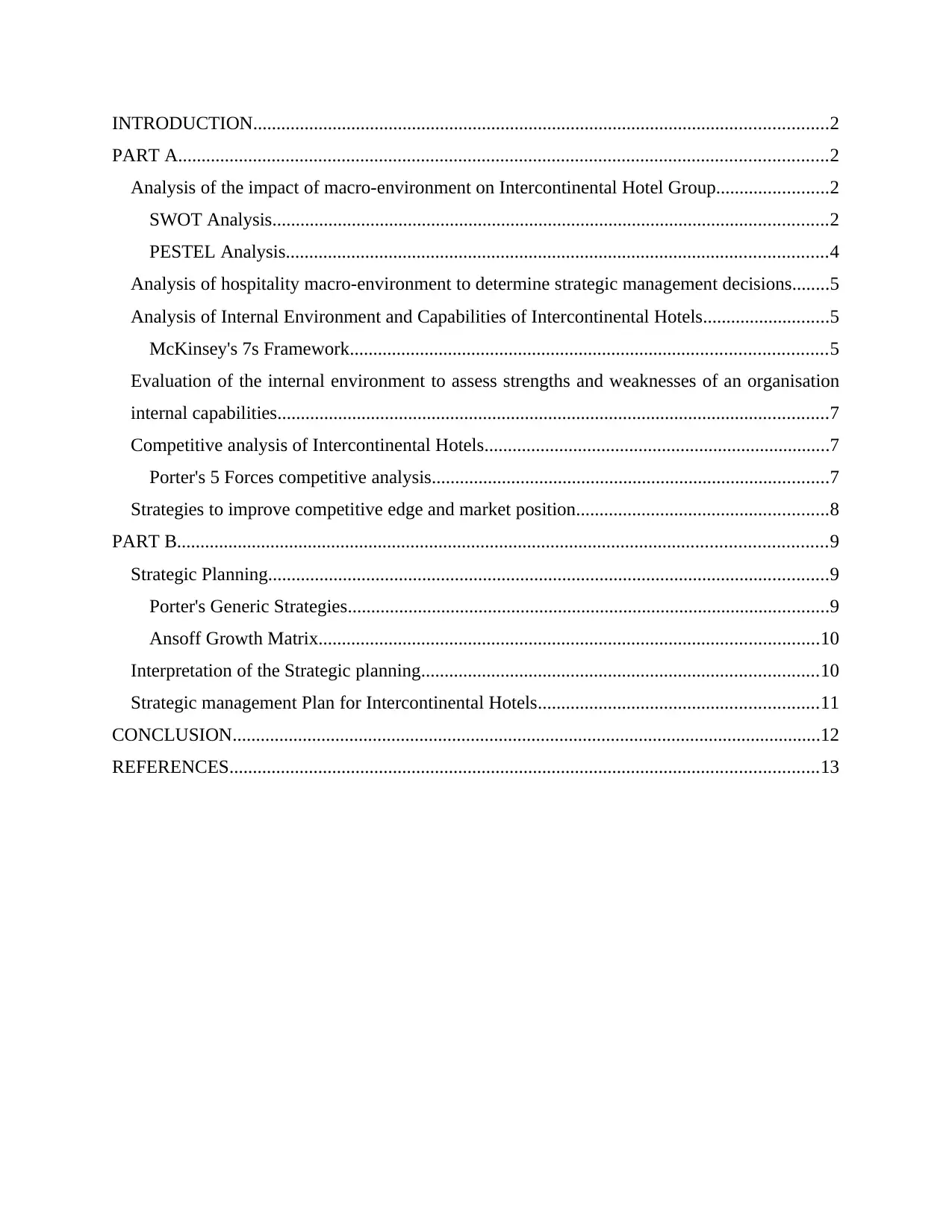
INTRODUCTION...........................................................................................................................2
PART A...........................................................................................................................................2
Analysis of the impact of macro-environment on Intercontinental Hotel Group........................2
SWOT Analysis.......................................................................................................................2
PESTEL Analysis....................................................................................................................4
Analysis of hospitality macro-environment to determine strategic management decisions........5
Analysis of Internal Environment and Capabilities of Intercontinental Hotels...........................5
McKinsey's 7s Framework......................................................................................................5
Evaluation of the internal environment to assess strengths and weaknesses of an organisation
internal capabilities......................................................................................................................7
Competitive analysis of Intercontinental Hotels..........................................................................7
Porter's 5 Forces competitive analysis.....................................................................................7
Strategies to improve competitive edge and market position......................................................8
PART B...........................................................................................................................................9
Strategic Planning........................................................................................................................9
Porter's Generic Strategies.......................................................................................................9
Ansoff Growth Matrix...........................................................................................................10
Interpretation of the Strategic planning.....................................................................................10
Strategic management Plan for Intercontinental Hotels............................................................11
CONCLUSION..............................................................................................................................12
REFERENCES..............................................................................................................................13
PART A...........................................................................................................................................2
Analysis of the impact of macro-environment on Intercontinental Hotel Group........................2
SWOT Analysis.......................................................................................................................2
PESTEL Analysis....................................................................................................................4
Analysis of hospitality macro-environment to determine strategic management decisions........5
Analysis of Internal Environment and Capabilities of Intercontinental Hotels...........................5
McKinsey's 7s Framework......................................................................................................5
Evaluation of the internal environment to assess strengths and weaknesses of an organisation
internal capabilities......................................................................................................................7
Competitive analysis of Intercontinental Hotels..........................................................................7
Porter's 5 Forces competitive analysis.....................................................................................7
Strategies to improve competitive edge and market position......................................................8
PART B...........................................................................................................................................9
Strategic Planning........................................................................................................................9
Porter's Generic Strategies.......................................................................................................9
Ansoff Growth Matrix...........................................................................................................10
Interpretation of the Strategic planning.....................................................................................10
Strategic management Plan for Intercontinental Hotels............................................................11
CONCLUSION..............................................................................................................................12
REFERENCES..............................................................................................................................13
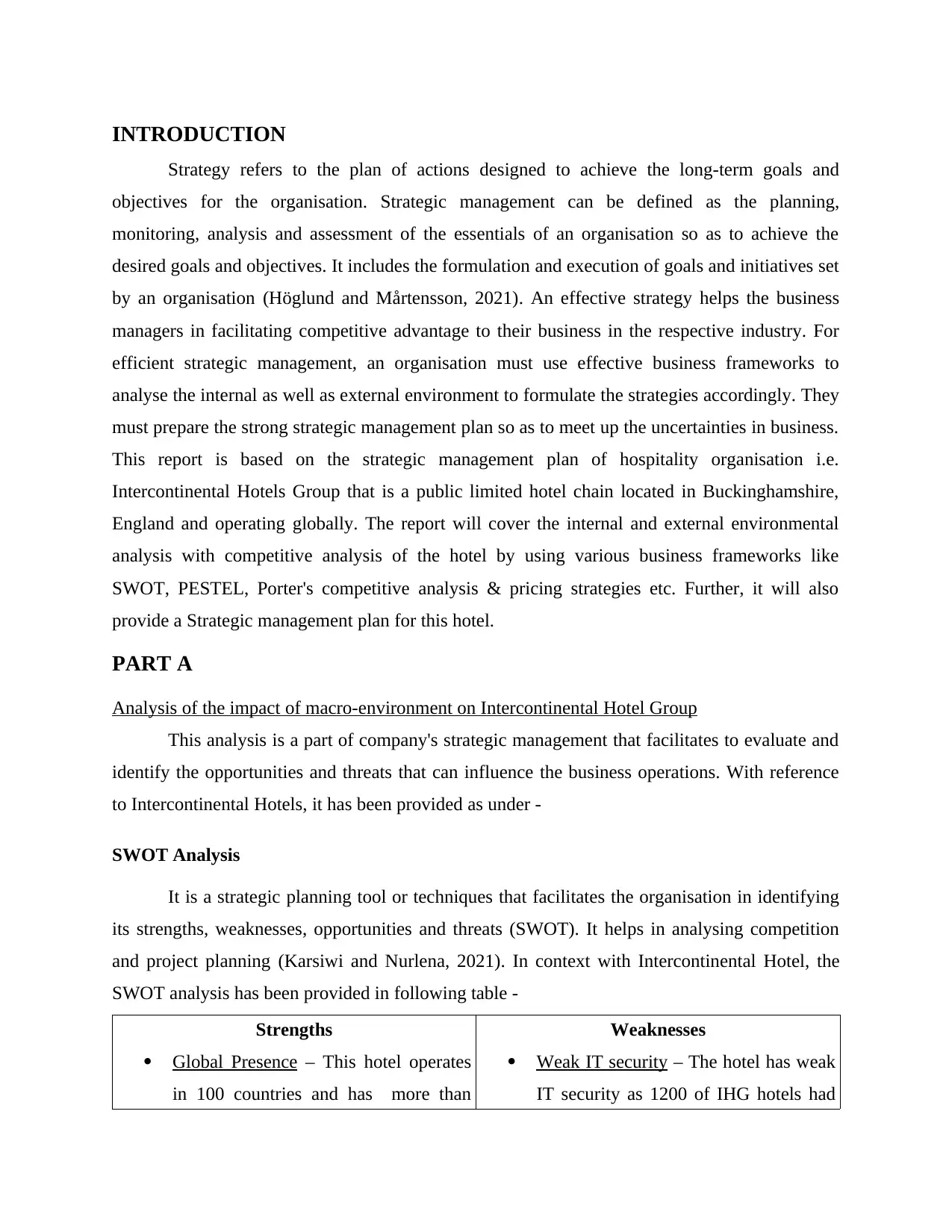
INTRODUCTION
Strategy refers to the plan of actions designed to achieve the long-term goals and
objectives for the organisation. Strategic management can be defined as the planning,
monitoring, analysis and assessment of the essentials of an organisation so as to achieve the
desired goals and objectives. It includes the formulation and execution of goals and initiatives set
by an organisation (Höglund and Mårtensson, 2021). An effective strategy helps the business
managers in facilitating competitive advantage to their business in the respective industry. For
efficient strategic management, an organisation must use effective business frameworks to
analyse the internal as well as external environment to formulate the strategies accordingly. They
must prepare the strong strategic management plan so as to meet up the uncertainties in business.
This report is based on the strategic management plan of hospitality organisation i.e.
Intercontinental Hotels Group that is a public limited hotel chain located in Buckinghamshire,
England and operating globally. The report will cover the internal and external environmental
analysis with competitive analysis of the hotel by using various business frameworks like
SWOT, PESTEL, Porter's competitive analysis & pricing strategies etc. Further, it will also
provide a Strategic management plan for this hotel.
PART A
Analysis of the impact of macro-environment on Intercontinental Hotel Group
This analysis is a part of company's strategic management that facilitates to evaluate and
identify the opportunities and threats that can influence the business operations. With reference
to Intercontinental Hotels, it has been provided as under -
SWOT Analysis
It is a strategic planning tool or techniques that facilitates the organisation in identifying
its strengths, weaknesses, opportunities and threats (SWOT). It helps in analysing competition
and project planning (Karsiwi and Nurlena, 2021). In context with Intercontinental Hotel, the
SWOT analysis has been provided in following table -
Strengths
Global Presence – This hotel operates
in 100 countries and has more than
Weaknesses
Weak IT security – The hotel has weak
IT security as 1200 of IHG hotels had
Strategy refers to the plan of actions designed to achieve the long-term goals and
objectives for the organisation. Strategic management can be defined as the planning,
monitoring, analysis and assessment of the essentials of an organisation so as to achieve the
desired goals and objectives. It includes the formulation and execution of goals and initiatives set
by an organisation (Höglund and Mårtensson, 2021). An effective strategy helps the business
managers in facilitating competitive advantage to their business in the respective industry. For
efficient strategic management, an organisation must use effective business frameworks to
analyse the internal as well as external environment to formulate the strategies accordingly. They
must prepare the strong strategic management plan so as to meet up the uncertainties in business.
This report is based on the strategic management plan of hospitality organisation i.e.
Intercontinental Hotels Group that is a public limited hotel chain located in Buckinghamshire,
England and operating globally. The report will cover the internal and external environmental
analysis with competitive analysis of the hotel by using various business frameworks like
SWOT, PESTEL, Porter's competitive analysis & pricing strategies etc. Further, it will also
provide a Strategic management plan for this hotel.
PART A
Analysis of the impact of macro-environment on Intercontinental Hotel Group
This analysis is a part of company's strategic management that facilitates to evaluate and
identify the opportunities and threats that can influence the business operations. With reference
to Intercontinental Hotels, it has been provided as under -
SWOT Analysis
It is a strategic planning tool or techniques that facilitates the organisation in identifying
its strengths, weaknesses, opportunities and threats (SWOT). It helps in analysing competition
and project planning (Karsiwi and Nurlena, 2021). In context with Intercontinental Hotel, the
SWOT analysis has been provided in following table -
Strengths
Global Presence – This hotel operates
in 100 countries and has more than
Weaknesses
Weak IT security – The hotel has weak
IT security as 1200 of IHG hotels had
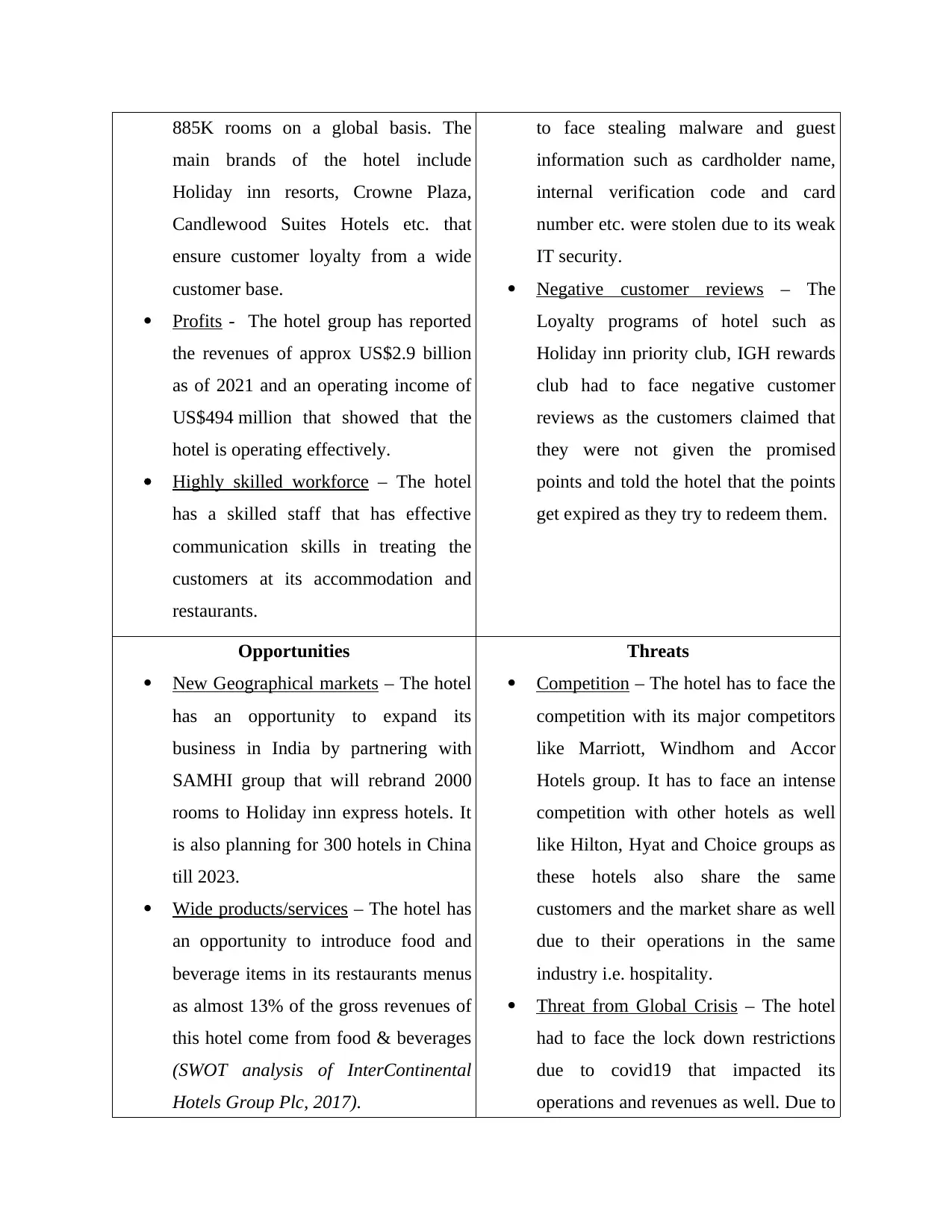
885K rooms on a global basis. The
main brands of the hotel include
Holiday inn resorts, Crowne Plaza,
Candlewood Suites Hotels etc. that
ensure customer loyalty from a wide
customer base.
Profits - The hotel group has reported
the revenues of approx US$2.9 billion
as of 2021 and an operating income of
US$494 million that showed that the
hotel is operating effectively.
Highly skilled workforce – The hotel
has a skilled staff that has effective
communication skills in treating the
customers at its accommodation and
restaurants.
to face stealing malware and guest
information such as cardholder name,
internal verification code and card
number etc. were stolen due to its weak
IT security.
Negative customer reviews – The
Loyalty programs of hotel such as
Holiday inn priority club, IGH rewards
club had to face negative customer
reviews as the customers claimed that
they were not given the promised
points and told the hotel that the points
get expired as they try to redeem them.
Opportunities
New Geographical markets – The hotel
has an opportunity to expand its
business in India by partnering with
SAMHI group that will rebrand 2000
rooms to Holiday inn express hotels. It
is also planning for 300 hotels in China
till 2023.
Wide products/services – The hotel has
an opportunity to introduce food and
beverage items in its restaurants menus
as almost 13% of the gross revenues of
this hotel come from food & beverages
(SWOT analysis of InterContinental
Hotels Group Plc, 2017).
Threats
Competition – The hotel has to face the
competition with its major competitors
like Marriott, Windhom and Accor
Hotels group. It has to face an intense
competition with other hotels as well
like Hilton, Hyat and Choice groups as
these hotels also share the same
customers and the market share as well
due to their operations in the same
industry i.e. hospitality.
Threat from Global Crisis – The hotel
had to face the lock down restrictions
due to covid19 that impacted its
operations and revenues as well. Due to
main brands of the hotel include
Holiday inn resorts, Crowne Plaza,
Candlewood Suites Hotels etc. that
ensure customer loyalty from a wide
customer base.
Profits - The hotel group has reported
the revenues of approx US$2.9 billion
as of 2021 and an operating income of
US$494 million that showed that the
hotel is operating effectively.
Highly skilled workforce – The hotel
has a skilled staff that has effective
communication skills in treating the
customers at its accommodation and
restaurants.
to face stealing malware and guest
information such as cardholder name,
internal verification code and card
number etc. were stolen due to its weak
IT security.
Negative customer reviews – The
Loyalty programs of hotel such as
Holiday inn priority club, IGH rewards
club had to face negative customer
reviews as the customers claimed that
they were not given the promised
points and told the hotel that the points
get expired as they try to redeem them.
Opportunities
New Geographical markets – The hotel
has an opportunity to expand its
business in India by partnering with
SAMHI group that will rebrand 2000
rooms to Holiday inn express hotels. It
is also planning for 300 hotels in China
till 2023.
Wide products/services – The hotel has
an opportunity to introduce food and
beverage items in its restaurants menus
as almost 13% of the gross revenues of
this hotel come from food & beverages
(SWOT analysis of InterContinental
Hotels Group Plc, 2017).
Threats
Competition – The hotel has to face the
competition with its major competitors
like Marriott, Windhom and Accor
Hotels group. It has to face an intense
competition with other hotels as well
like Hilton, Hyat and Choice groups as
these hotels also share the same
customers and the market share as well
due to their operations in the same
industry i.e. hospitality.
Threat from Global Crisis – The hotel
had to face the lock down restrictions
due to covid19 that impacted its
operations and revenues as well. Due to
Secure Best Marks with AI Grader
Need help grading? Try our AI Grader for instant feedback on your assignments.
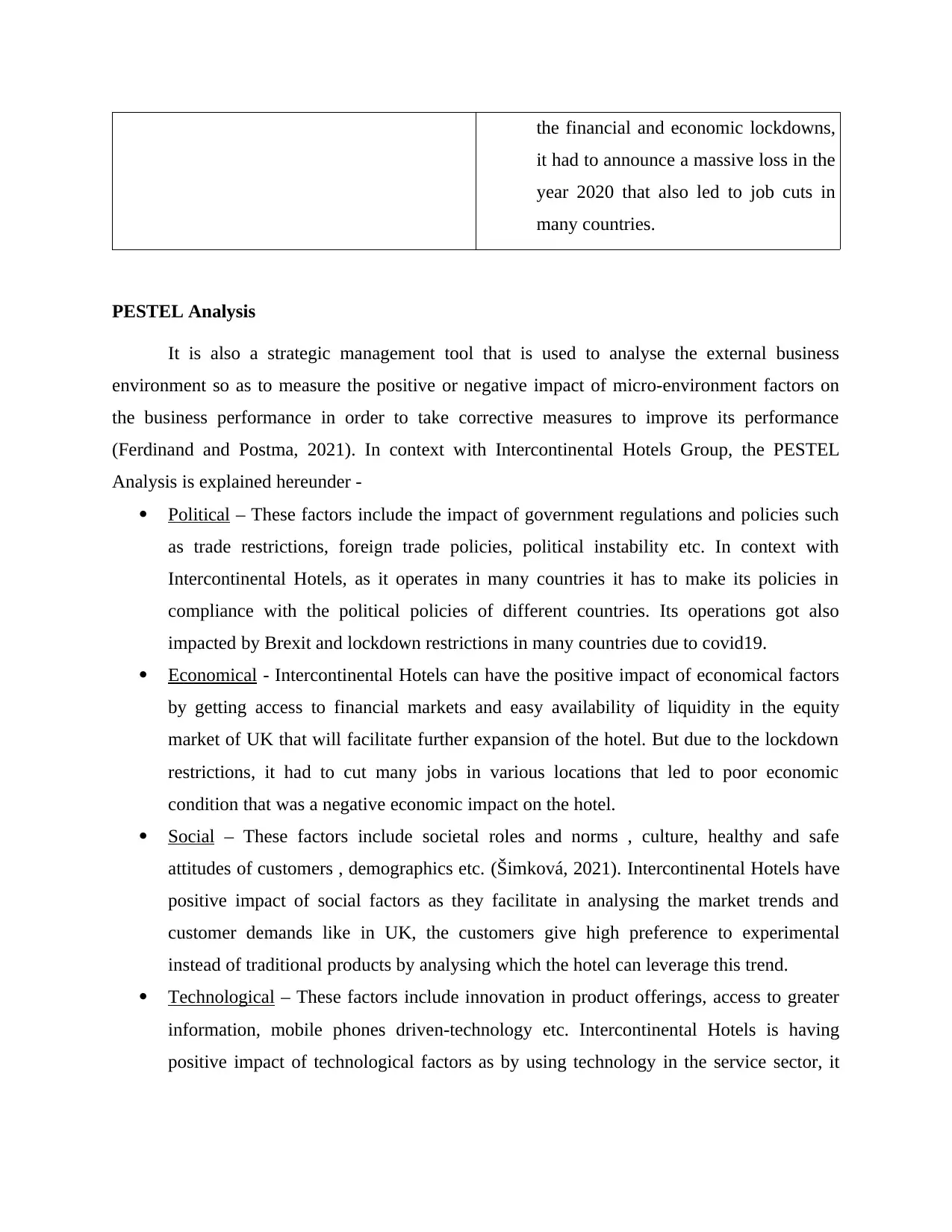
the financial and economic lockdowns,
it had to announce a massive loss in the
year 2020 that also led to job cuts in
many countries.
PESTEL Analysis
It is also a strategic management tool that is used to analyse the external business
environment so as to measure the positive or negative impact of micro-environment factors on
the business performance in order to take corrective measures to improve its performance
(Ferdinand and Postma, 2021). In context with Intercontinental Hotels Group, the PESTEL
Analysis is explained hereunder -
Political – These factors include the impact of government regulations and policies such
as trade restrictions, foreign trade policies, political instability etc. In context with
Intercontinental Hotels, as it operates in many countries it has to make its policies in
compliance with the political policies of different countries. Its operations got also
impacted by Brexit and lockdown restrictions in many countries due to covid19.
Economical - Intercontinental Hotels can have the positive impact of economical factors
by getting access to financial markets and easy availability of liquidity in the equity
market of UK that will facilitate further expansion of the hotel. But due to the lockdown
restrictions, it had to cut many jobs in various locations that led to poor economic
condition that was a negative economic impact on the hotel.
Social – These factors include societal roles and norms , culture, healthy and safe
attitudes of customers , demographics etc. (Šimková, 2021). Intercontinental Hotels have
positive impact of social factors as they facilitate in analysing the market trends and
customer demands like in UK, the customers give high preference to experimental
instead of traditional products by analysing which the hotel can leverage this trend.
Technological – These factors include innovation in product offerings, access to greater
information, mobile phones driven-technology etc. Intercontinental Hotels is having
positive impact of technological factors as by using technology in the service sector, it
it had to announce a massive loss in the
year 2020 that also led to job cuts in
many countries.
PESTEL Analysis
It is also a strategic management tool that is used to analyse the external business
environment so as to measure the positive or negative impact of micro-environment factors on
the business performance in order to take corrective measures to improve its performance
(Ferdinand and Postma, 2021). In context with Intercontinental Hotels Group, the PESTEL
Analysis is explained hereunder -
Political – These factors include the impact of government regulations and policies such
as trade restrictions, foreign trade policies, political instability etc. In context with
Intercontinental Hotels, as it operates in many countries it has to make its policies in
compliance with the political policies of different countries. Its operations got also
impacted by Brexit and lockdown restrictions in many countries due to covid19.
Economical - Intercontinental Hotels can have the positive impact of economical factors
by getting access to financial markets and easy availability of liquidity in the equity
market of UK that will facilitate further expansion of the hotel. But due to the lockdown
restrictions, it had to cut many jobs in various locations that led to poor economic
condition that was a negative economic impact on the hotel.
Social – These factors include societal roles and norms , culture, healthy and safe
attitudes of customers , demographics etc. (Šimková, 2021). Intercontinental Hotels have
positive impact of social factors as they facilitate in analysing the market trends and
customer demands like in UK, the customers give high preference to experimental
instead of traditional products by analysing which the hotel can leverage this trend.
Technological – These factors include innovation in product offerings, access to greater
information, mobile phones driven-technology etc. Intercontinental Hotels is having
positive impact of technological factors as by using technology in the service sector, it
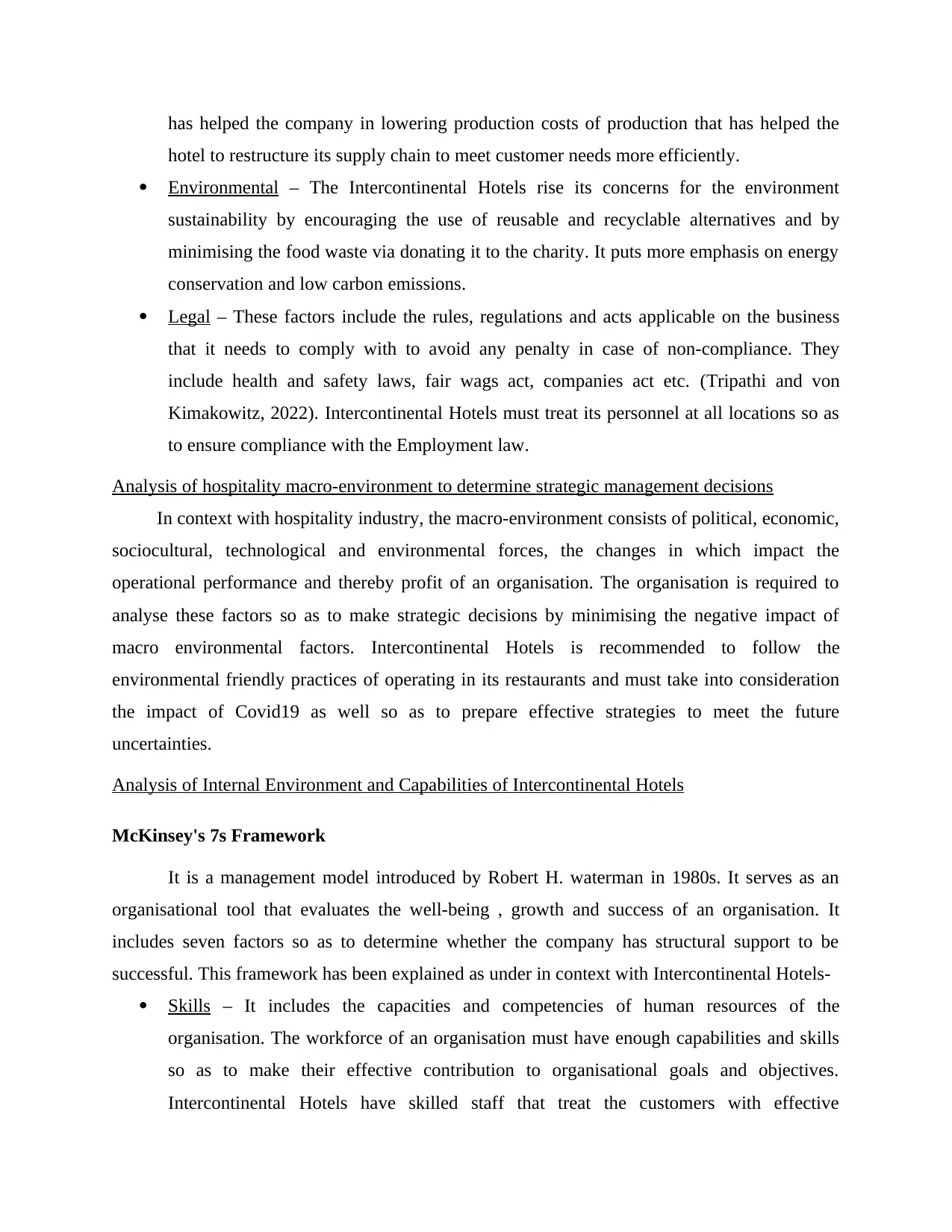
has helped the company in lowering production costs of production that has helped the
hotel to restructure its supply chain to meet customer needs more efficiently.
Environmental – The Intercontinental Hotels rise its concerns for the environment
sustainability by encouraging the use of reusable and recyclable alternatives and by
minimising the food waste via donating it to the charity. It puts more emphasis on energy
conservation and low carbon emissions.
Legal – These factors include the rules, regulations and acts applicable on the business
that it needs to comply with to avoid any penalty in case of non-compliance. They
include health and safety laws, fair wags act, companies act etc. (Tripathi and von
Kimakowitz, 2022). Intercontinental Hotels must treat its personnel at all locations so as
to ensure compliance with the Employment law.
Analysis of hospitality macro-environment to determine strategic management decisions
In context with hospitality industry, the macro-environment consists of political, economic,
sociocultural, technological and environmental forces, the changes in which impact the
operational performance and thereby profit of an organisation. The organisation is required to
analyse these factors so as to make strategic decisions by minimising the negative impact of
macro environmental factors. Intercontinental Hotels is recommended to follow the
environmental friendly practices of operating in its restaurants and must take into consideration
the impact of Covid19 as well so as to prepare effective strategies to meet the future
uncertainties.
Analysis of Internal Environment and Capabilities of Intercontinental Hotels
McKinsey's 7s Framework
It is a management model introduced by Robert H. waterman in 1980s. It serves as an
organisational tool that evaluates the well-being , growth and success of an organisation. It
includes seven factors so as to determine whether the company has structural support to be
successful. This framework has been explained as under in context with Intercontinental Hotels-
Skills – It includes the capacities and competencies of human resources of the
organisation. The workforce of an organisation must have enough capabilities and skills
so as to make their effective contribution to organisational goals and objectives.
Intercontinental Hotels have skilled staff that treat the customers with effective
hotel to restructure its supply chain to meet customer needs more efficiently.
Environmental – The Intercontinental Hotels rise its concerns for the environment
sustainability by encouraging the use of reusable and recyclable alternatives and by
minimising the food waste via donating it to the charity. It puts more emphasis on energy
conservation and low carbon emissions.
Legal – These factors include the rules, regulations and acts applicable on the business
that it needs to comply with to avoid any penalty in case of non-compliance. They
include health and safety laws, fair wags act, companies act etc. (Tripathi and von
Kimakowitz, 2022). Intercontinental Hotels must treat its personnel at all locations so as
to ensure compliance with the Employment law.
Analysis of hospitality macro-environment to determine strategic management decisions
In context with hospitality industry, the macro-environment consists of political, economic,
sociocultural, technological and environmental forces, the changes in which impact the
operational performance and thereby profit of an organisation. The organisation is required to
analyse these factors so as to make strategic decisions by minimising the negative impact of
macro environmental factors. Intercontinental Hotels is recommended to follow the
environmental friendly practices of operating in its restaurants and must take into consideration
the impact of Covid19 as well so as to prepare effective strategies to meet the future
uncertainties.
Analysis of Internal Environment and Capabilities of Intercontinental Hotels
McKinsey's 7s Framework
It is a management model introduced by Robert H. waterman in 1980s. It serves as an
organisational tool that evaluates the well-being , growth and success of an organisation. It
includes seven factors so as to determine whether the company has structural support to be
successful. This framework has been explained as under in context with Intercontinental Hotels-
Skills – It includes the capacities and competencies of human resources of the
organisation. The workforce of an organisation must have enough capabilities and skills
so as to make their effective contribution to organisational goals and objectives.
Intercontinental Hotels have skilled staff that treat the customers with effective
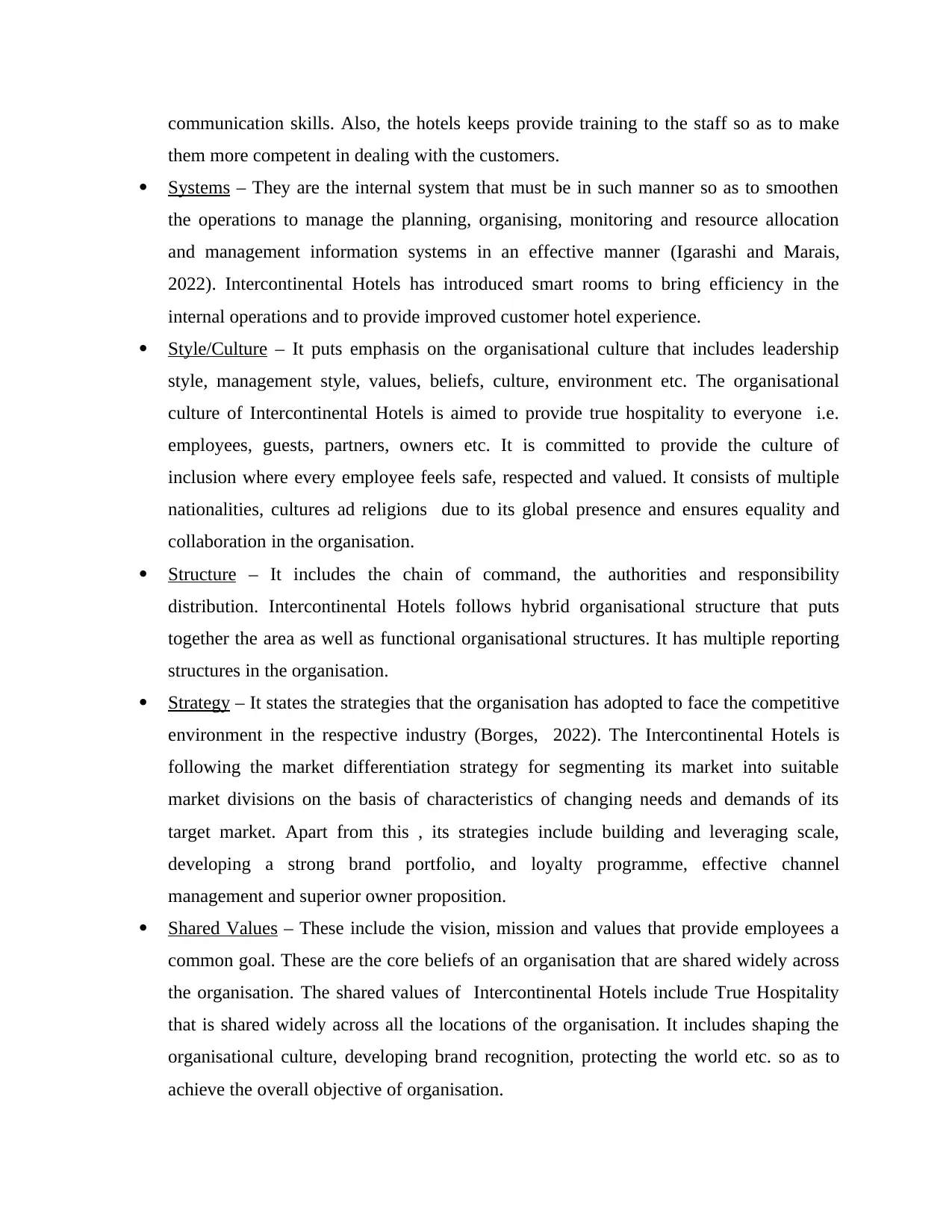
communication skills. Also, the hotels keeps provide training to the staff so as to make
them more competent in dealing with the customers.
Systems – They are the internal system that must be in such manner so as to smoothen
the operations to manage the planning, organising, monitoring and resource allocation
and management information systems in an effective manner (Igarashi and Marais,
2022). Intercontinental Hotels has introduced smart rooms to bring efficiency in the
internal operations and to provide improved customer hotel experience.
Style/Culture – It puts emphasis on the organisational culture that includes leadership
style, management style, values, beliefs, culture, environment etc. The organisational
culture of Intercontinental Hotels is aimed to provide true hospitality to everyone i.e.
employees, guests, partners, owners etc. It is committed to provide the culture of
inclusion where every employee feels safe, respected and valued. It consists of multiple
nationalities, cultures ad religions due to its global presence and ensures equality and
collaboration in the organisation.
Structure – It includes the chain of command, the authorities and responsibility
distribution. Intercontinental Hotels follows hybrid organisational structure that puts
together the area as well as functional organisational structures. It has multiple reporting
structures in the organisation.
Strategy – It states the strategies that the organisation has adopted to face the competitive
environment in the respective industry (Borges, 2022). The Intercontinental Hotels is
following the market differentiation strategy for segmenting its market into suitable
market divisions on the basis of characteristics of changing needs and demands of its
target market. Apart from this , its strategies include building and leveraging scale,
developing a strong brand portfolio, and loyalty programme, effective channel
management and superior owner proposition.
Shared Values – These include the vision, mission and values that provide employees a
common goal. These are the core beliefs of an organisation that are shared widely across
the organisation. The shared values of Intercontinental Hotels include True Hospitality
that is shared widely across all the locations of the organisation. It includes shaping the
organisational culture, developing brand recognition, protecting the world etc. so as to
achieve the overall objective of organisation.
them more competent in dealing with the customers.
Systems – They are the internal system that must be in such manner so as to smoothen
the operations to manage the planning, organising, monitoring and resource allocation
and management information systems in an effective manner (Igarashi and Marais,
2022). Intercontinental Hotels has introduced smart rooms to bring efficiency in the
internal operations and to provide improved customer hotel experience.
Style/Culture – It puts emphasis on the organisational culture that includes leadership
style, management style, values, beliefs, culture, environment etc. The organisational
culture of Intercontinental Hotels is aimed to provide true hospitality to everyone i.e.
employees, guests, partners, owners etc. It is committed to provide the culture of
inclusion where every employee feels safe, respected and valued. It consists of multiple
nationalities, cultures ad religions due to its global presence and ensures equality and
collaboration in the organisation.
Structure – It includes the chain of command, the authorities and responsibility
distribution. Intercontinental Hotels follows hybrid organisational structure that puts
together the area as well as functional organisational structures. It has multiple reporting
structures in the organisation.
Strategy – It states the strategies that the organisation has adopted to face the competitive
environment in the respective industry (Borges, 2022). The Intercontinental Hotels is
following the market differentiation strategy for segmenting its market into suitable
market divisions on the basis of characteristics of changing needs and demands of its
target market. Apart from this , its strategies include building and leveraging scale,
developing a strong brand portfolio, and loyalty programme, effective channel
management and superior owner proposition.
Shared Values – These include the vision, mission and values that provide employees a
common goal. These are the core beliefs of an organisation that are shared widely across
the organisation. The shared values of Intercontinental Hotels include True Hospitality
that is shared widely across all the locations of the organisation. It includes shaping the
organisational culture, developing brand recognition, protecting the world etc. so as to
achieve the overall objective of organisation.
Paraphrase This Document
Need a fresh take? Get an instant paraphrase of this document with our AI Paraphraser
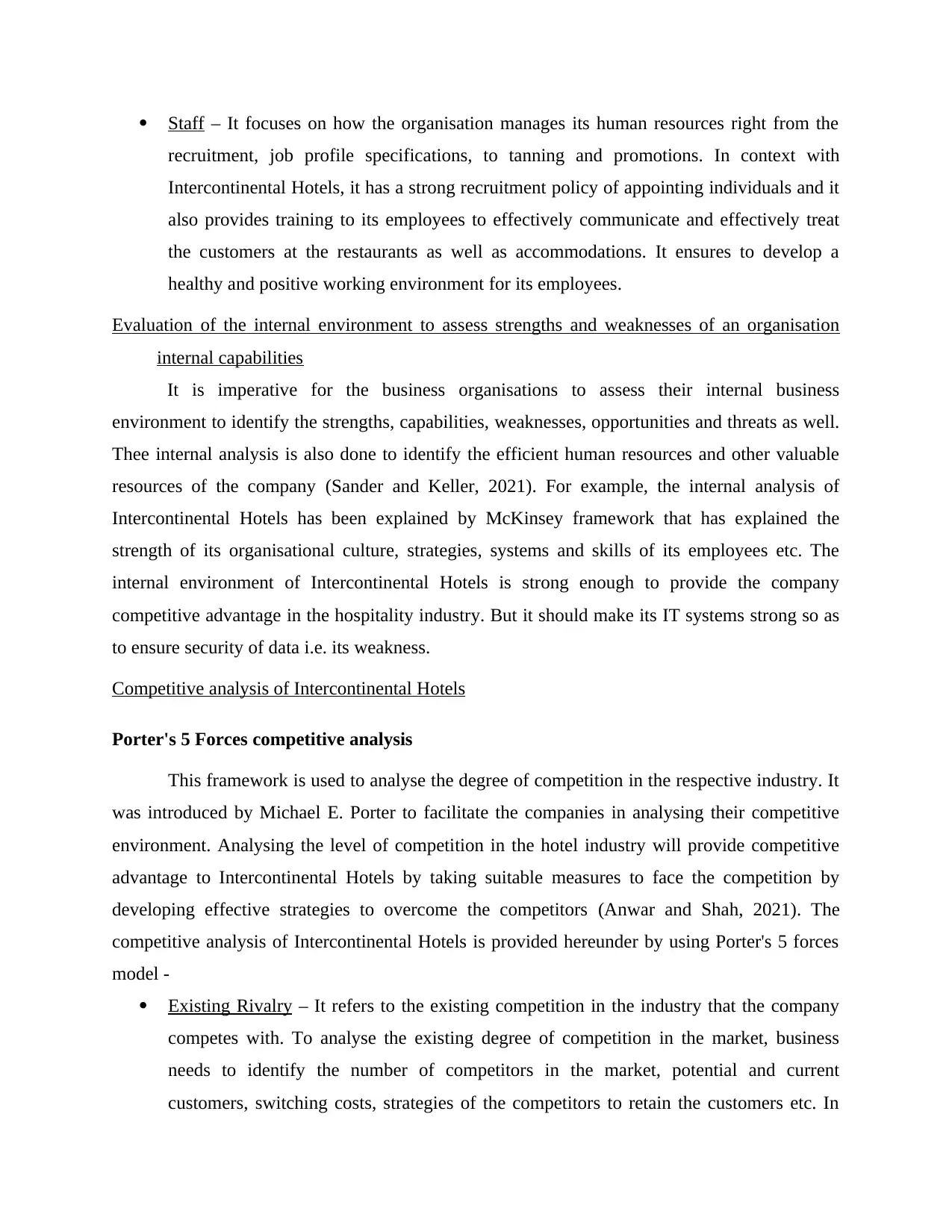
Staff – It focuses on how the organisation manages its human resources right from the
recruitment, job profile specifications, to tanning and promotions. In context with
Intercontinental Hotels, it has a strong recruitment policy of appointing individuals and it
also provides training to its employees to effectively communicate and effectively treat
the customers at the restaurants as well as accommodations. It ensures to develop a
healthy and positive working environment for its employees.
Evaluation of the internal environment to assess strengths and weaknesses of an organisation
internal capabilities
It is imperative for the business organisations to assess their internal business
environment to identify the strengths, capabilities, weaknesses, opportunities and threats as well.
Thee internal analysis is also done to identify the efficient human resources and other valuable
resources of the company (Sander and Keller, 2021). For example, the internal analysis of
Intercontinental Hotels has been explained by McKinsey framework that has explained the
strength of its organisational culture, strategies, systems and skills of its employees etc. The
internal environment of Intercontinental Hotels is strong enough to provide the company
competitive advantage in the hospitality industry. But it should make its IT systems strong so as
to ensure security of data i.e. its weakness.
Competitive analysis of Intercontinental Hotels
Porter's 5 Forces competitive analysis
This framework is used to analyse the degree of competition in the respective industry. It
was introduced by Michael E. Porter to facilitate the companies in analysing their competitive
environment. Analysing the level of competition in the hotel industry will provide competitive
advantage to Intercontinental Hotels by taking suitable measures to face the competition by
developing effective strategies to overcome the competitors (Anwar and Shah, 2021). The
competitive analysis of Intercontinental Hotels is provided hereunder by using Porter's 5 forces
model -
Existing Rivalry – It refers to the existing competition in the industry that the company
competes with. To analyse the existing degree of competition in the market, business
needs to identify the number of competitors in the market, potential and current
customers, switching costs, strategies of the competitors to retain the customers etc. In
recruitment, job profile specifications, to tanning and promotions. In context with
Intercontinental Hotels, it has a strong recruitment policy of appointing individuals and it
also provides training to its employees to effectively communicate and effectively treat
the customers at the restaurants as well as accommodations. It ensures to develop a
healthy and positive working environment for its employees.
Evaluation of the internal environment to assess strengths and weaknesses of an organisation
internal capabilities
It is imperative for the business organisations to assess their internal business
environment to identify the strengths, capabilities, weaknesses, opportunities and threats as well.
Thee internal analysis is also done to identify the efficient human resources and other valuable
resources of the company (Sander and Keller, 2021). For example, the internal analysis of
Intercontinental Hotels has been explained by McKinsey framework that has explained the
strength of its organisational culture, strategies, systems and skills of its employees etc. The
internal environment of Intercontinental Hotels is strong enough to provide the company
competitive advantage in the hospitality industry. But it should make its IT systems strong so as
to ensure security of data i.e. its weakness.
Competitive analysis of Intercontinental Hotels
Porter's 5 Forces competitive analysis
This framework is used to analyse the degree of competition in the respective industry. It
was introduced by Michael E. Porter to facilitate the companies in analysing their competitive
environment. Analysing the level of competition in the hotel industry will provide competitive
advantage to Intercontinental Hotels by taking suitable measures to face the competition by
developing effective strategies to overcome the competitors (Anwar and Shah, 2021). The
competitive analysis of Intercontinental Hotels is provided hereunder by using Porter's 5 forces
model -
Existing Rivalry – It refers to the existing competition in the industry that the company
competes with. To analyse the existing degree of competition in the market, business
needs to identify the number of competitors in the market, potential and current
customers, switching costs, strategies of the competitors to retain the customers etc. In
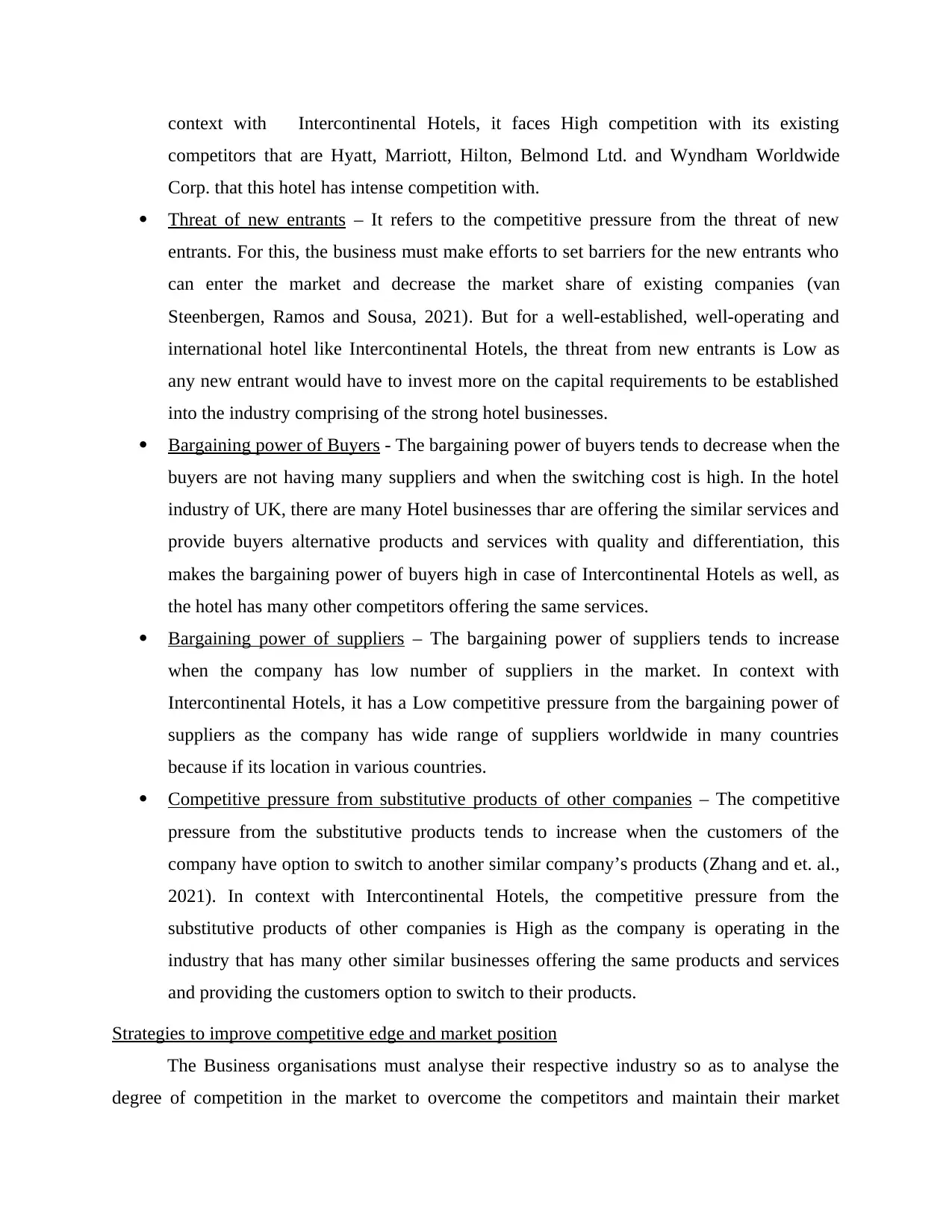
context with Intercontinental Hotels, it faces High competition with its existing
competitors that are Hyatt, Marriott, Hilton, Belmond Ltd. and Wyndham Worldwide
Corp. that this hotel has intense competition with.
Threat of new entrants – It refers to the competitive pressure from the threat of new
entrants. For this, the business must make efforts to set barriers for the new entrants who
can enter the market and decrease the market share of existing companies (van
Steenbergen, Ramos and Sousa, 2021). But for a well-established, well-operating and
international hotel like Intercontinental Hotels, the threat from new entrants is Low as
any new entrant would have to invest more on the capital requirements to be established
into the industry comprising of the strong hotel businesses.
Bargaining power of Buyers - The bargaining power of buyers tends to decrease when the
buyers are not having many suppliers and when the switching cost is high. In the hotel
industry of UK, there are many Hotel businesses thar are offering the similar services and
provide buyers alternative products and services with quality and differentiation, this
makes the bargaining power of buyers high in case of Intercontinental Hotels as well, as
the hotel has many other competitors offering the same services.
Bargaining power of suppliers – The bargaining power of suppliers tends to increase
when the company has low number of suppliers in the market. In context with
Intercontinental Hotels, it has a Low competitive pressure from the bargaining power of
suppliers as the company has wide range of suppliers worldwide in many countries
because if its location in various countries.
Competitive pressure from substitutive products of other companies – The competitive
pressure from the substitutive products tends to increase when the customers of the
company have option to switch to another similar company’s products (Zhang and et. al.,
2021). In context with Intercontinental Hotels, the competitive pressure from the
substitutive products of other companies is High as the company is operating in the
industry that has many other similar businesses offering the same products and services
and providing the customers option to switch to their products.
Strategies to improve competitive edge and market position
The Business organisations must analyse their respective industry so as to analyse the
degree of competition in the market to overcome the competitors and maintain their market
competitors that are Hyatt, Marriott, Hilton, Belmond Ltd. and Wyndham Worldwide
Corp. that this hotel has intense competition with.
Threat of new entrants – It refers to the competitive pressure from the threat of new
entrants. For this, the business must make efforts to set barriers for the new entrants who
can enter the market and decrease the market share of existing companies (van
Steenbergen, Ramos and Sousa, 2021). But for a well-established, well-operating and
international hotel like Intercontinental Hotels, the threat from new entrants is Low as
any new entrant would have to invest more on the capital requirements to be established
into the industry comprising of the strong hotel businesses.
Bargaining power of Buyers - The bargaining power of buyers tends to decrease when the
buyers are not having many suppliers and when the switching cost is high. In the hotel
industry of UK, there are many Hotel businesses thar are offering the similar services and
provide buyers alternative products and services with quality and differentiation, this
makes the bargaining power of buyers high in case of Intercontinental Hotels as well, as
the hotel has many other competitors offering the same services.
Bargaining power of suppliers – The bargaining power of suppliers tends to increase
when the company has low number of suppliers in the market. In context with
Intercontinental Hotels, it has a Low competitive pressure from the bargaining power of
suppliers as the company has wide range of suppliers worldwide in many countries
because if its location in various countries.
Competitive pressure from substitutive products of other companies – The competitive
pressure from the substitutive products tends to increase when the customers of the
company have option to switch to another similar company’s products (Zhang and et. al.,
2021). In context with Intercontinental Hotels, the competitive pressure from the
substitutive products of other companies is High as the company is operating in the
industry that has many other similar businesses offering the same products and services
and providing the customers option to switch to their products.
Strategies to improve competitive edge and market position
The Business organisations must analyse their respective industry so as to analyse the
degree of competition in the market to overcome the competitors and maintain their market
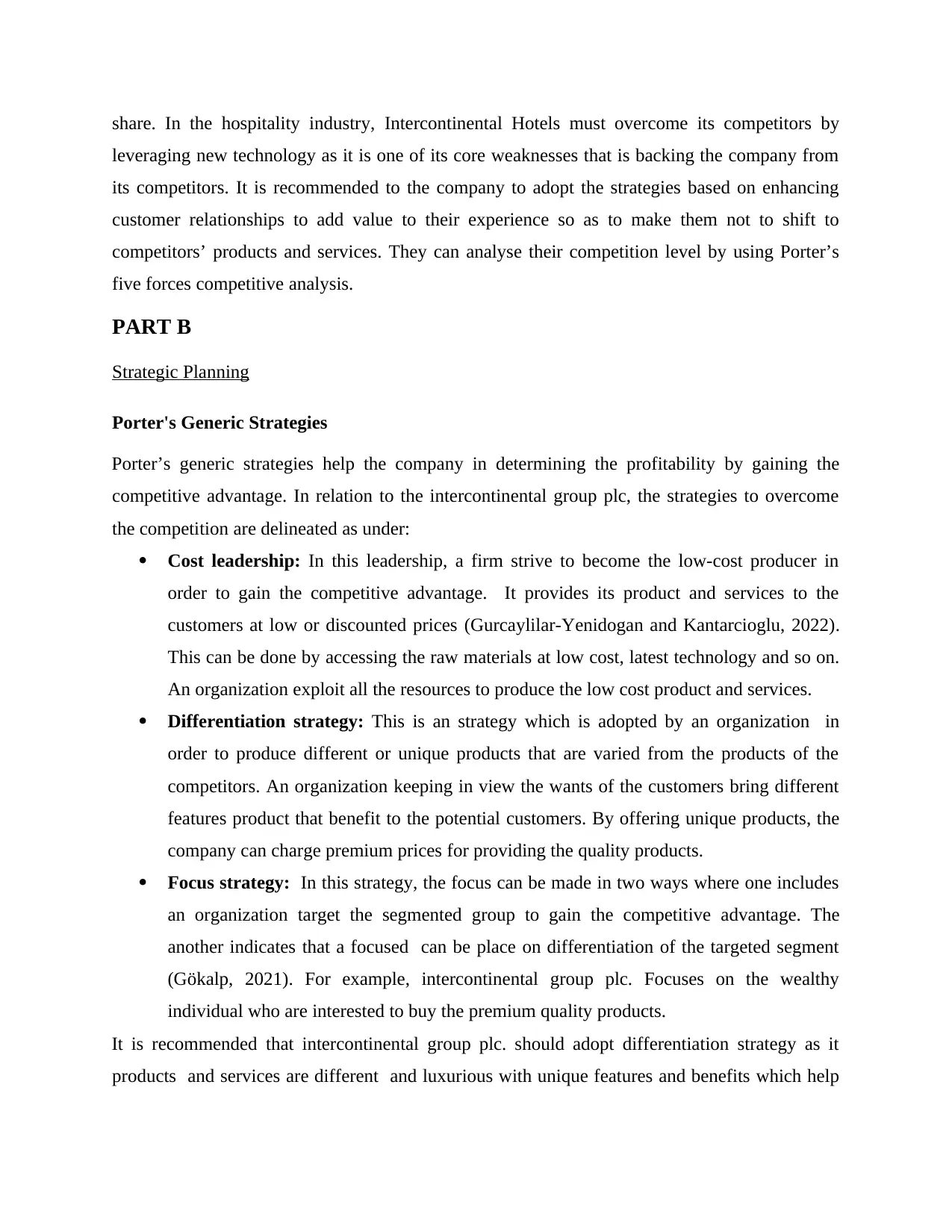
share. In the hospitality industry, Intercontinental Hotels must overcome its competitors by
leveraging new technology as it is one of its core weaknesses that is backing the company from
its competitors. It is recommended to the company to adopt the strategies based on enhancing
customer relationships to add value to their experience so as to make them not to shift to
competitors’ products and services. They can analyse their competition level by using Porter’s
five forces competitive analysis.
PART B
Strategic Planning
Porter's Generic Strategies
Porter’s generic strategies help the company in determining the profitability by gaining the
competitive advantage. In relation to the intercontinental group plc, the strategies to overcome
the competition are delineated as under:
Cost leadership: In this leadership, a firm strive to become the low-cost producer in
order to gain the competitive advantage. It provides its product and services to the
customers at low or discounted prices (Gurcaylilar-Yenidogan and Kantarcioglu, 2022).
This can be done by accessing the raw materials at low cost, latest technology and so on.
An organization exploit all the resources to produce the low cost product and services.
Differentiation strategy: This is an strategy which is adopted by an organization in
order to produce different or unique products that are varied from the products of the
competitors. An organization keeping in view the wants of the customers bring different
features product that benefit to the potential customers. By offering unique products, the
company can charge premium prices for providing the quality products.
Focus strategy: In this strategy, the focus can be made in two ways where one includes
an organization target the segmented group to gain the competitive advantage. The
another indicates that a focused can be place on differentiation of the targeted segment
(Gökalp, 2021). For example, intercontinental group plc. Focuses on the wealthy
individual who are interested to buy the premium quality products.
It is recommended that intercontinental group plc. should adopt differentiation strategy as it
products and services are different and luxurious with unique features and benefits which help
leveraging new technology as it is one of its core weaknesses that is backing the company from
its competitors. It is recommended to the company to adopt the strategies based on enhancing
customer relationships to add value to their experience so as to make them not to shift to
competitors’ products and services. They can analyse their competition level by using Porter’s
five forces competitive analysis.
PART B
Strategic Planning
Porter's Generic Strategies
Porter’s generic strategies help the company in determining the profitability by gaining the
competitive advantage. In relation to the intercontinental group plc, the strategies to overcome
the competition are delineated as under:
Cost leadership: In this leadership, a firm strive to become the low-cost producer in
order to gain the competitive advantage. It provides its product and services to the
customers at low or discounted prices (Gurcaylilar-Yenidogan and Kantarcioglu, 2022).
This can be done by accessing the raw materials at low cost, latest technology and so on.
An organization exploit all the resources to produce the low cost product and services.
Differentiation strategy: This is an strategy which is adopted by an organization in
order to produce different or unique products that are varied from the products of the
competitors. An organization keeping in view the wants of the customers bring different
features product that benefit to the potential customers. By offering unique products, the
company can charge premium prices for providing the quality products.
Focus strategy: In this strategy, the focus can be made in two ways where one includes
an organization target the segmented group to gain the competitive advantage. The
another indicates that a focused can be place on differentiation of the targeted segment
(Gökalp, 2021). For example, intercontinental group plc. Focuses on the wealthy
individual who are interested to buy the premium quality products.
It is recommended that intercontinental group plc. should adopt differentiation strategy as it
products and services are different and luxurious with unique features and benefits which help
Secure Best Marks with AI Grader
Need help grading? Try our AI Grader for instant feedback on your assignments.
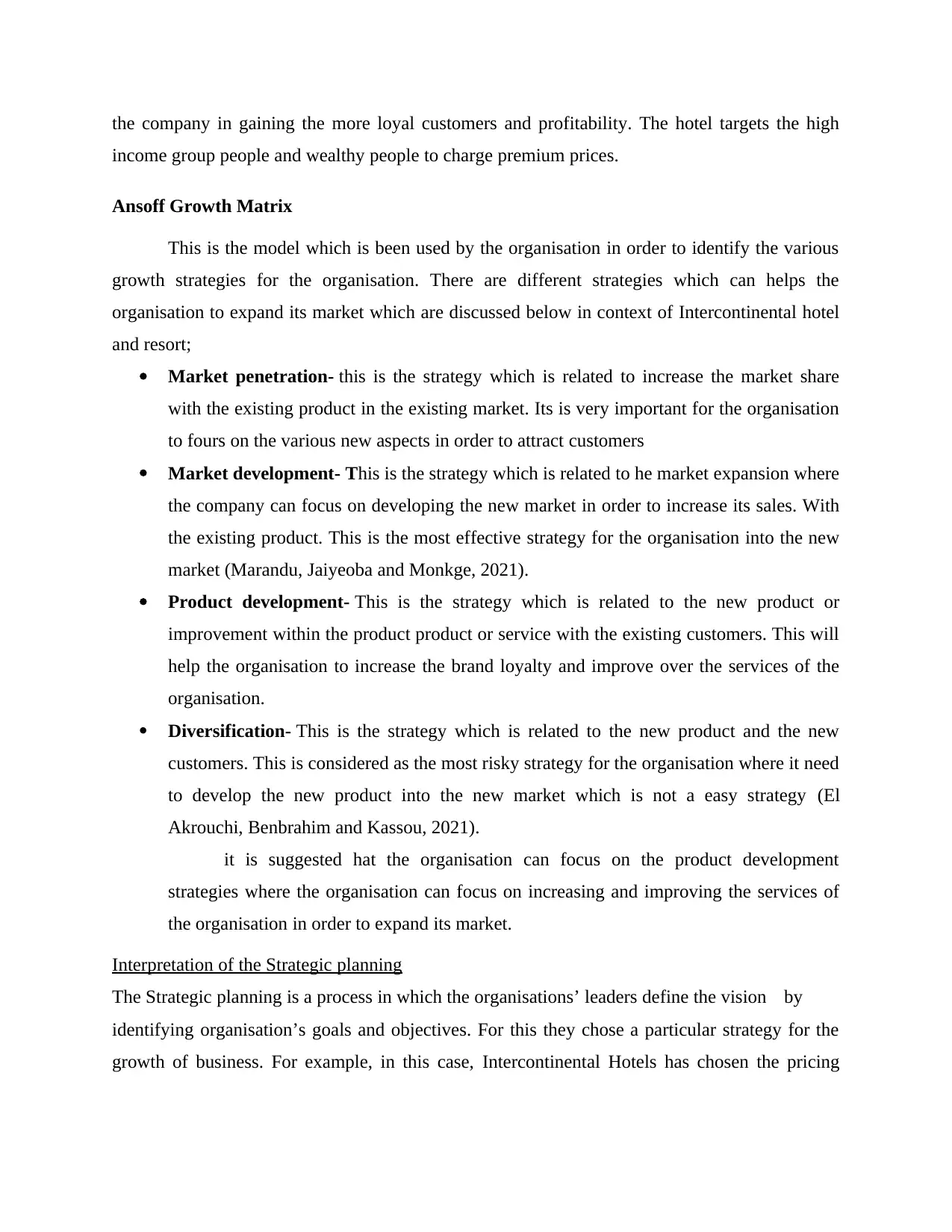
the company in gaining the more loyal customers and profitability. The hotel targets the high
income group people and wealthy people to charge premium prices.
Ansoff Growth Matrix
This is the model which is been used by the organisation in order to identify the various
growth strategies for the organisation. There are different strategies which can helps the
organisation to expand its market which are discussed below in context of Intercontinental hotel
and resort;
Market penetration- this is the strategy which is related to increase the market share
with the existing product in the existing market. Its is very important for the organisation
to fours on the various new aspects in order to attract customers
Market development- This is the strategy which is related to he market expansion where
the company can focus on developing the new market in order to increase its sales. With
the existing product. This is the most effective strategy for the organisation into the new
market (Marandu, Jaiyeoba and Monkge, 2021).
Product development- This is the strategy which is related to the new product or
improvement within the product product or service with the existing customers. This will
help the organisation to increase the brand loyalty and improve over the services of the
organisation.
Diversification- This is the strategy which is related to the new product and the new
customers. This is considered as the most risky strategy for the organisation where it need
to develop the new product into the new market which is not a easy strategy (El
Akrouchi, Benbrahim and Kassou, 2021).
it is suggested hat the organisation can focus on the product development
strategies where the organisation can focus on increasing and improving the services of
the organisation in order to expand its market.
Interpretation of the Strategic planning
The Strategic planning is a process in which the organisations’ leaders define the vision by
identifying organisation’s goals and objectives. For this they chose a particular strategy for the
growth of business. For example, in this case, Intercontinental Hotels has chosen the pricing
income group people and wealthy people to charge premium prices.
Ansoff Growth Matrix
This is the model which is been used by the organisation in order to identify the various
growth strategies for the organisation. There are different strategies which can helps the
organisation to expand its market which are discussed below in context of Intercontinental hotel
and resort;
Market penetration- this is the strategy which is related to increase the market share
with the existing product in the existing market. Its is very important for the organisation
to fours on the various new aspects in order to attract customers
Market development- This is the strategy which is related to he market expansion where
the company can focus on developing the new market in order to increase its sales. With
the existing product. This is the most effective strategy for the organisation into the new
market (Marandu, Jaiyeoba and Monkge, 2021).
Product development- This is the strategy which is related to the new product or
improvement within the product product or service with the existing customers. This will
help the organisation to increase the brand loyalty and improve over the services of the
organisation.
Diversification- This is the strategy which is related to the new product and the new
customers. This is considered as the most risky strategy for the organisation where it need
to develop the new product into the new market which is not a easy strategy (El
Akrouchi, Benbrahim and Kassou, 2021).
it is suggested hat the organisation can focus on the product development
strategies where the organisation can focus on increasing and improving the services of
the organisation in order to expand its market.
Interpretation of the Strategic planning
The Strategic planning is a process in which the organisations’ leaders define the vision by
identifying organisation’s goals and objectives. For this they chose a particular strategy for the
growth of business. For example, in this case, Intercontinental Hotels has chosen the pricing
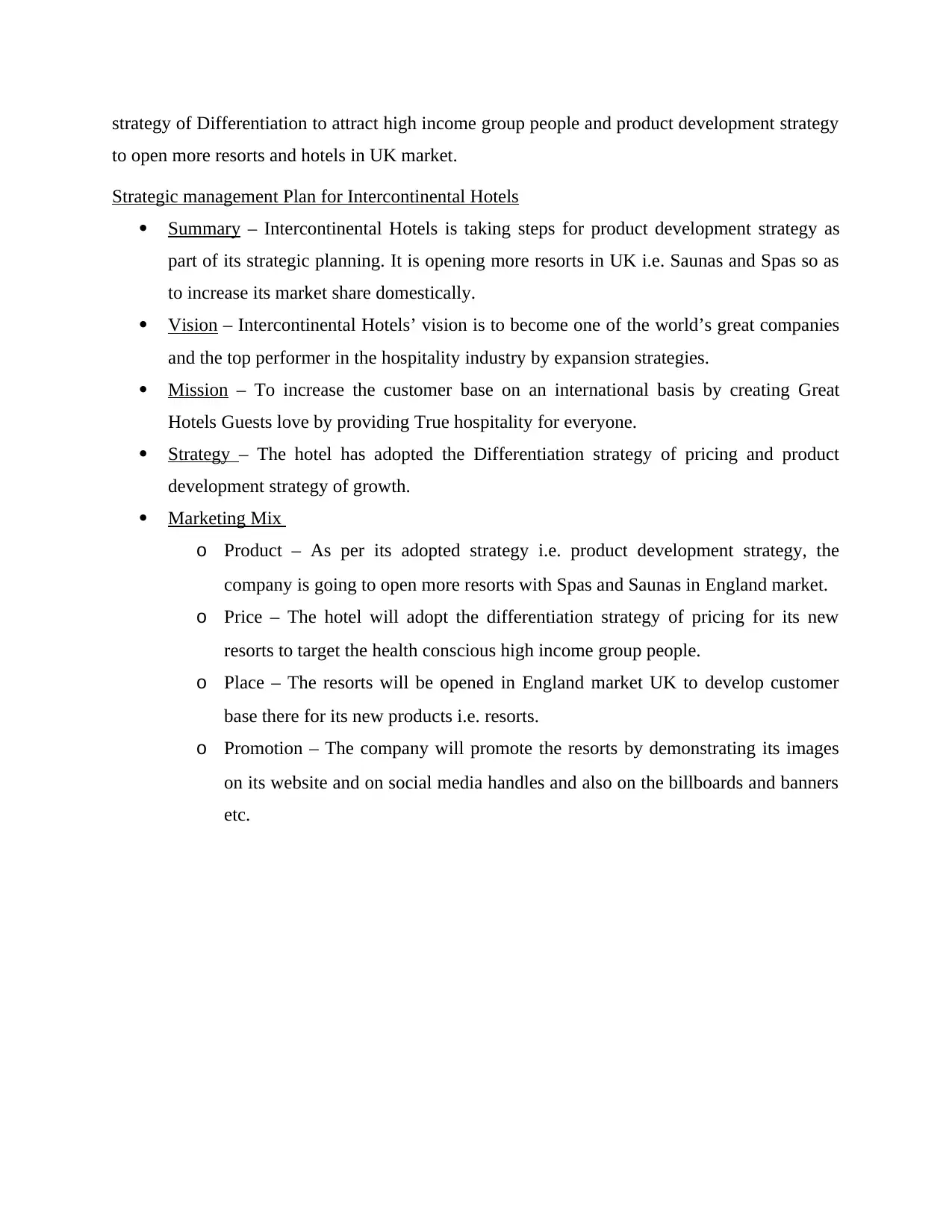
strategy of Differentiation to attract high income group people and product development strategy
to open more resorts and hotels in UK market.
Strategic management Plan for Intercontinental Hotels
Summary – Intercontinental Hotels is taking steps for product development strategy as
part of its strategic planning. It is opening more resorts in UK i.e. Saunas and Spas so as
to increase its market share domestically.
Vision – Intercontinental Hotels’ vision is to become one of the world’s great companies
and the top performer in the hospitality industry by expansion strategies.
Mission – To increase the customer base on an international basis by creating Great
Hotels Guests love by providing True hospitality for everyone.
Strategy – The hotel has adopted the Differentiation strategy of pricing and product
development strategy of growth.
Marketing Mix
o Product – As per its adopted strategy i.e. product development strategy, the
company is going to open more resorts with Spas and Saunas in England market.
o Price – The hotel will adopt the differentiation strategy of pricing for its new
resorts to target the health conscious high income group people.
o Place – The resorts will be opened in England market UK to develop customer
base there for its new products i.e. resorts.
o Promotion – The company will promote the resorts by demonstrating its images
on its website and on social media handles and also on the billboards and banners
etc.
to open more resorts and hotels in UK market.
Strategic management Plan for Intercontinental Hotels
Summary – Intercontinental Hotels is taking steps for product development strategy as
part of its strategic planning. It is opening more resorts in UK i.e. Saunas and Spas so as
to increase its market share domestically.
Vision – Intercontinental Hotels’ vision is to become one of the world’s great companies
and the top performer in the hospitality industry by expansion strategies.
Mission – To increase the customer base on an international basis by creating Great
Hotels Guests love by providing True hospitality for everyone.
Strategy – The hotel has adopted the Differentiation strategy of pricing and product
development strategy of growth.
Marketing Mix
o Product – As per its adopted strategy i.e. product development strategy, the
company is going to open more resorts with Spas and Saunas in England market.
o Price – The hotel will adopt the differentiation strategy of pricing for its new
resorts to target the health conscious high income group people.
o Place – The resorts will be opened in England market UK to develop customer
base there for its new products i.e. resorts.
o Promotion – The company will promote the resorts by demonstrating its images
on its website and on social media handles and also on the billboards and banners
etc.
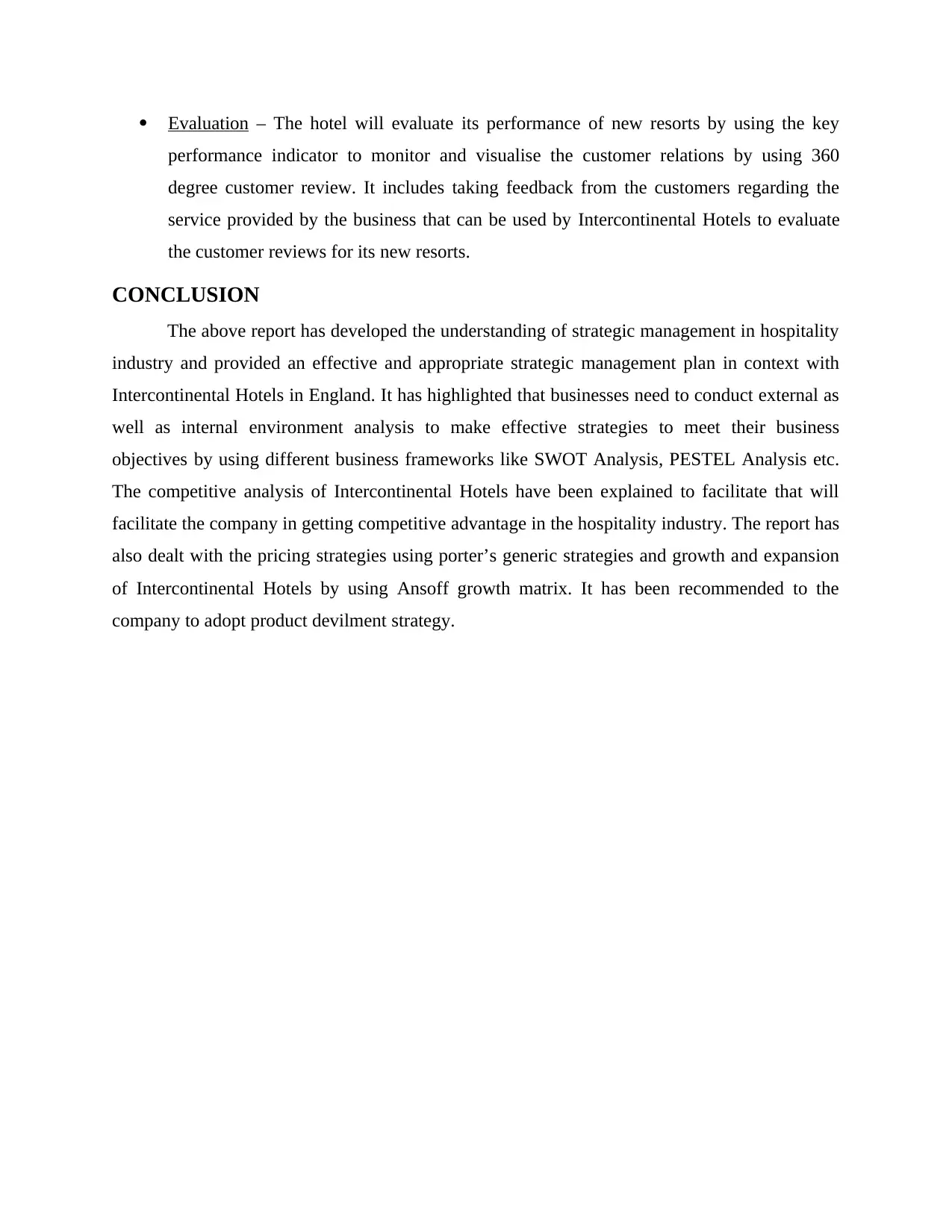
Evaluation – The hotel will evaluate its performance of new resorts by using the key
performance indicator to monitor and visualise the customer relations by using 360
degree customer review. It includes taking feedback from the customers regarding the
service provided by the business that can be used by Intercontinental Hotels to evaluate
the customer reviews for its new resorts.
CONCLUSION
The above report has developed the understanding of strategic management in hospitality
industry and provided an effective and appropriate strategic management plan in context with
Intercontinental Hotels in England. It has highlighted that businesses need to conduct external as
well as internal environment analysis to make effective strategies to meet their business
objectives by using different business frameworks like SWOT Analysis, PESTEL Analysis etc.
The competitive analysis of Intercontinental Hotels have been explained to facilitate that will
facilitate the company in getting competitive advantage in the hospitality industry. The report has
also dealt with the pricing strategies using porter’s generic strategies and growth and expansion
of Intercontinental Hotels by using Ansoff growth matrix. It has been recommended to the
company to adopt product devilment strategy.
performance indicator to monitor and visualise the customer relations by using 360
degree customer review. It includes taking feedback from the customers regarding the
service provided by the business that can be used by Intercontinental Hotels to evaluate
the customer reviews for its new resorts.
CONCLUSION
The above report has developed the understanding of strategic management in hospitality
industry and provided an effective and appropriate strategic management plan in context with
Intercontinental Hotels in England. It has highlighted that businesses need to conduct external as
well as internal environment analysis to make effective strategies to meet their business
objectives by using different business frameworks like SWOT Analysis, PESTEL Analysis etc.
The competitive analysis of Intercontinental Hotels have been explained to facilitate that will
facilitate the company in getting competitive advantage in the hospitality industry. The report has
also dealt with the pricing strategies using porter’s generic strategies and growth and expansion
of Intercontinental Hotels by using Ansoff growth matrix. It has been recommended to the
company to adopt product devilment strategy.
Paraphrase This Document
Need a fresh take? Get an instant paraphrase of this document with our AI Paraphraser
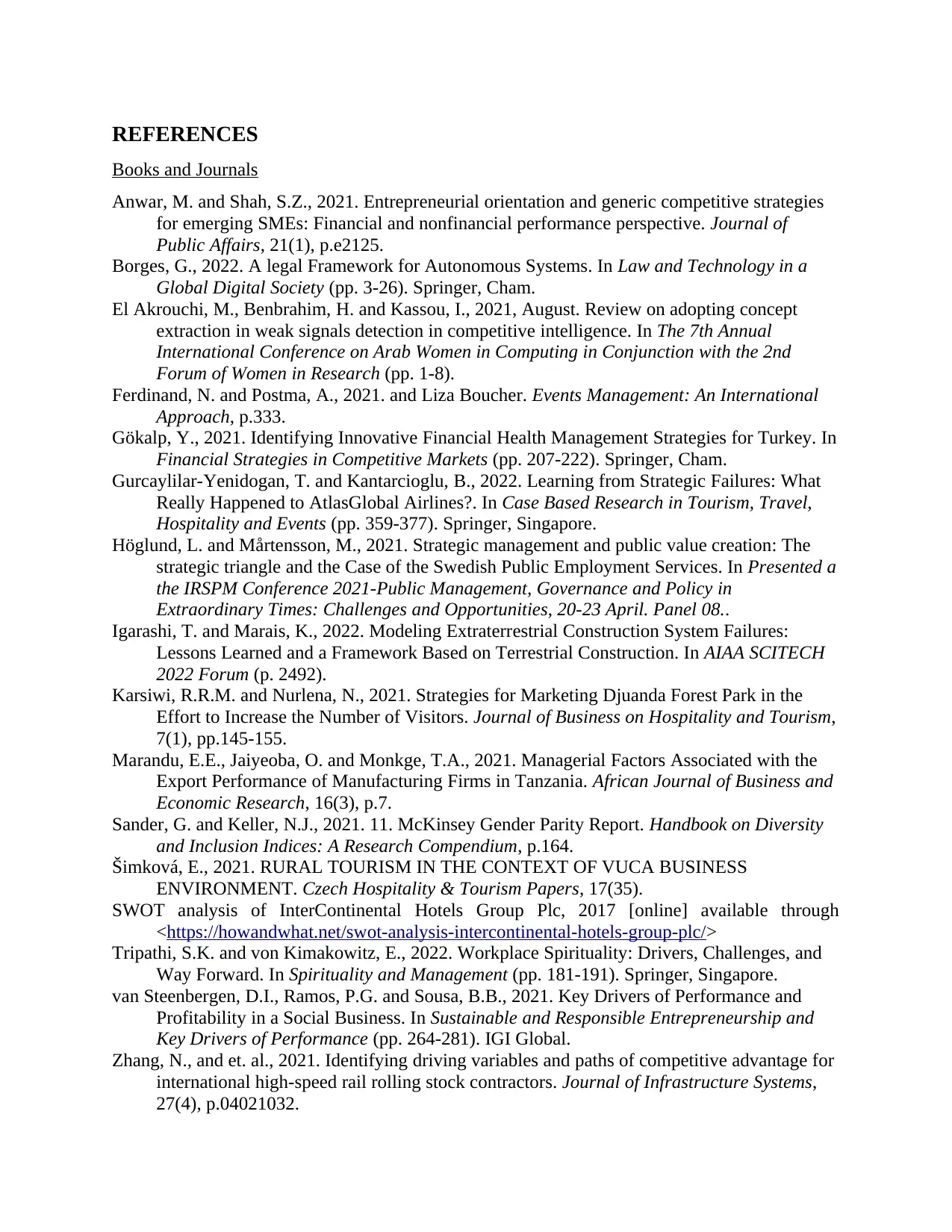
REFERENCES
Books and Journals
Anwar, M. and Shah, S.Z., 2021. Entrepreneurial orientation and generic competitive strategies
for emerging SMEs: Financial and nonfinancial performance perspective. Journal of
Public Affairs, 21(1), p.e2125.
Borges, G., 2022. A legal Framework for Autonomous Systems. In Law and Technology in a
Global Digital Society (pp. 3-26). Springer, Cham.
El Akrouchi, M., Benbrahim, H. and Kassou, I., 2021, August. Review on adopting concept
extraction in weak signals detection in competitive intelligence. In The 7th Annual
International Conference on Arab Women in Computing in Conjunction with the 2nd
Forum of Women in Research (pp. 1-8).
Ferdinand, N. and Postma, A., 2021. and Liza Boucher. Events Management: An International
Approach, p.333.
Gökalp, Y., 2021. Identifying Innovative Financial Health Management Strategies for Turkey. In
Financial Strategies in Competitive Markets (pp. 207-222). Springer, Cham.
Gurcaylilar-Yenidogan, T. and Kantarcioglu, B., 2022. Learning from Strategic Failures: What
Really Happened to AtlasGlobal Airlines?. In Case Based Research in Tourism, Travel,
Hospitality and Events (pp. 359-377). Springer, Singapore.
Höglund, L. and Mårtensson, M., 2021. Strategic management and public value creation: The
strategic triangle and the Case of the Swedish Public Employment Services. In Presented a
the IRSPM Conference 2021-Public Management, Governance and Policy in
Extraordinary Times: Challenges and Opportunities, 20-23 April. Panel 08..
Igarashi, T. and Marais, K., 2022. Modeling Extraterrestrial Construction System Failures:
Lessons Learned and a Framework Based on Terrestrial Construction. In AIAA SCITECH
2022 Forum (p. 2492).
Karsiwi, R.R.M. and Nurlena, N., 2021. Strategies for Marketing Djuanda Forest Park in the
Effort to Increase the Number of Visitors. Journal of Business on Hospitality and Tourism,
7(1), pp.145-155.
Marandu, E.E., Jaiyeoba, O. and Monkge, T.A., 2021. Managerial Factors Associated with the
Export Performance of Manufacturing Firms in Tanzania. African Journal of Business and
Economic Research, 16(3), p.7.
Sander, G. and Keller, N.J., 2021. 11. McKinsey Gender Parity Report. Handbook on Diversity
and Inclusion Indices: A Research Compendium, p.164.
Šimková, E., 2021. RURAL TOURISM IN THE CONTEXT OF VUCA BUSINESS
ENVIRONMENT. Czech Hospitality & Tourism Papers, 17(35).
SWOT analysis of InterContinental Hotels Group Plc, 2017 [online] available through
<https://howandwhat.net/swot-analysis-intercontinental-hotels-group-plc/>
Tripathi, S.K. and von Kimakowitz, E., 2022. Workplace Spirituality: Drivers, Challenges, and
Way Forward. In Spirituality and Management (pp. 181-191). Springer, Singapore.
van Steenbergen, D.I., Ramos, P.G. and Sousa, B.B., 2021. Key Drivers of Performance and
Profitability in a Social Business. In Sustainable and Responsible Entrepreneurship and
Key Drivers of Performance (pp. 264-281). IGI Global.
Zhang, N., and et. al., 2021. Identifying driving variables and paths of competitive advantage for
international high-speed rail rolling stock contractors. Journal of Infrastructure Systems,
27(4), p.04021032.
Books and Journals
Anwar, M. and Shah, S.Z., 2021. Entrepreneurial orientation and generic competitive strategies
for emerging SMEs: Financial and nonfinancial performance perspective. Journal of
Public Affairs, 21(1), p.e2125.
Borges, G., 2022. A legal Framework for Autonomous Systems. In Law and Technology in a
Global Digital Society (pp. 3-26). Springer, Cham.
El Akrouchi, M., Benbrahim, H. and Kassou, I., 2021, August. Review on adopting concept
extraction in weak signals detection in competitive intelligence. In The 7th Annual
International Conference on Arab Women in Computing in Conjunction with the 2nd
Forum of Women in Research (pp. 1-8).
Ferdinand, N. and Postma, A., 2021. and Liza Boucher. Events Management: An International
Approach, p.333.
Gökalp, Y., 2021. Identifying Innovative Financial Health Management Strategies for Turkey. In
Financial Strategies in Competitive Markets (pp. 207-222). Springer, Cham.
Gurcaylilar-Yenidogan, T. and Kantarcioglu, B., 2022. Learning from Strategic Failures: What
Really Happened to AtlasGlobal Airlines?. In Case Based Research in Tourism, Travel,
Hospitality and Events (pp. 359-377). Springer, Singapore.
Höglund, L. and Mårtensson, M., 2021. Strategic management and public value creation: The
strategic triangle and the Case of the Swedish Public Employment Services. In Presented a
the IRSPM Conference 2021-Public Management, Governance and Policy in
Extraordinary Times: Challenges and Opportunities, 20-23 April. Panel 08..
Igarashi, T. and Marais, K., 2022. Modeling Extraterrestrial Construction System Failures:
Lessons Learned and a Framework Based on Terrestrial Construction. In AIAA SCITECH
2022 Forum (p. 2492).
Karsiwi, R.R.M. and Nurlena, N., 2021. Strategies for Marketing Djuanda Forest Park in the
Effort to Increase the Number of Visitors. Journal of Business on Hospitality and Tourism,
7(1), pp.145-155.
Marandu, E.E., Jaiyeoba, O. and Monkge, T.A., 2021. Managerial Factors Associated with the
Export Performance of Manufacturing Firms in Tanzania. African Journal of Business and
Economic Research, 16(3), p.7.
Sander, G. and Keller, N.J., 2021. 11. McKinsey Gender Parity Report. Handbook on Diversity
and Inclusion Indices: A Research Compendium, p.164.
Šimková, E., 2021. RURAL TOURISM IN THE CONTEXT OF VUCA BUSINESS
ENVIRONMENT. Czech Hospitality & Tourism Papers, 17(35).
SWOT analysis of InterContinental Hotels Group Plc, 2017 [online] available through
<https://howandwhat.net/swot-analysis-intercontinental-hotels-group-plc/>
Tripathi, S.K. and von Kimakowitz, E., 2022. Workplace Spirituality: Drivers, Challenges, and
Way Forward. In Spirituality and Management (pp. 181-191). Springer, Singapore.
van Steenbergen, D.I., Ramos, P.G. and Sousa, B.B., 2021. Key Drivers of Performance and
Profitability in a Social Business. In Sustainable and Responsible Entrepreneurship and
Key Drivers of Performance (pp. 264-281). IGI Global.
Zhang, N., and et. al., 2021. Identifying driving variables and paths of competitive advantage for
international high-speed rail rolling stock contractors. Journal of Infrastructure Systems,
27(4), p.04021032.
1 out of 14
Related Documents
Your All-in-One AI-Powered Toolkit for Academic Success.
+13062052269
info@desklib.com
Available 24*7 on WhatsApp / Email
![[object Object]](/_next/static/media/star-bottom.7253800d.svg)
Unlock your academic potential
© 2024 | Zucol Services PVT LTD | All rights reserved.


